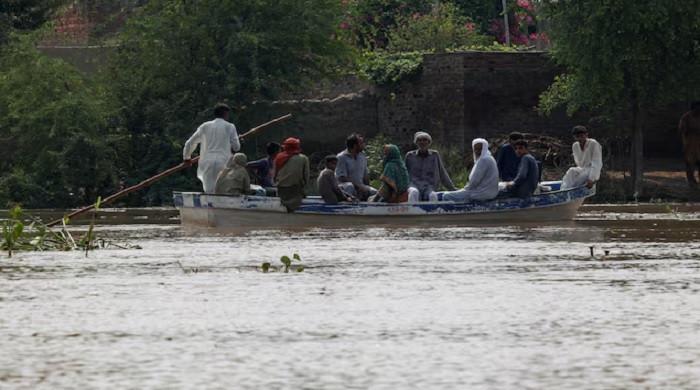- Mass evacuations underway as raging riverwaters spill over.
- NDMA says India has also released waters from its Thein Dam.
- Punjab writes to interior ministry requesting deployment of troops.
The National Disaster Management Authority (NDMA) has warned that Lahore and other parts of Punjab face a “very high to exceptionally high” flood threat, as heavy rains and India’s release of water from two dams swelled rivers and led authorities to seek army assistance in six districts.
Both nations have been hit by intense monsoon rains and flooding in recent weeks.
The release of excess water from India’s dams threatens to further flood parts of Punjab province, which serves as the country’s breadbasket and is home to half of its 240 million people.
Relentless rains coupled with water releases from India have pushed the rivers into dangerous territory, forcing authorities to raise the alarm.
As a result, floodwaters surged in the Ravi, Chenab, and Sutlej, causing breaches in Narowal, Sialkot, and Shakargarh with reports that in Zafarwal, part of Hanjli Bridge collapsed under the pressure of Nullah Dek, cutting off road links to dozens of villages.
‘Extreme’ situation
The NDMA in its latest advisory eaerly on Wednesday described the situation as “extreme” and warned that vulnerable areas are already under threat.
The Ravi, swelling rapidly at Jassar, is carrying 170,000 cusecs of water and is projected to surge to 250,000 cusecs by morning — a volume that could overwhelm embankments and inundate nearby settlements.
The Chenab at Marala, always a critical flashpoint during high monsoon flows, could see a staggering 690,000 cusecs, while the Sutlej at Ganda Singh Wala is already heaving with 245,000 cusecs — with more still to come.
Rescue authorities are scrambling to prepare. The NDMA has urged families in low-lying areas to move to safer ground, warning that waiting any longer could put lives at risk.
In Shahdara and along the Motorway-2 stretch, the Ravi has been creeping up fast, forcing people to prepare for the possibility of evacuation.
Officials have also been telling citizens to cut down on travel unless absolutely necessary and to stay in touch with local rescue teams.
“The rivers are unforgiving right now,” one official remarked, stressing that the next few hours will show whether the protective walls hold — or whether neighbourhoods on the fringe will have to be cleared out at short notice.
India’s release of an additional 200,000 cusecs into the Ravi and the expected 100,000 cusecs into the Chenab has raised fears of very high flooding in the next 48 hours.
Rescue teams continued shifting stranded residents by boats from river-adjacent areas, while Shakargarh’s Nullah Bainsi and Nullah Basantar overflowed, submerging connecting roads and several villages.
Army called in for rescue efforts
The provincial government has called in the army to help civil authorities as floodwaters continue to disrupt life in six districts, including Lahore, Kasur, Sialkot, Faisalabad, Narowal and Okara.
Officials said district administrations in the affected areas had sought immediate military assistance to protect lives and support ongoing rescue operations.
Rescue 1122, civil defence, police and local administration are already on the ground, but the scale of the crisis has stretched their resources thin.
The Punjab Home Department has formally written to the federal interior ministry requesting deployment of troops in the six districts.
‘Next 48 hours critical’
Provincial Disaster Management Authority (PDMA) said late on Tuesday that India had opened all the gates of its Thein Dam on the Ravi River.
India’s water resources ministry did not immediately respond to a request for comment.
The announcement came a day after Pakistan received a secondwarning from India that it intended to release water from the rapidly filling Madhopur Dam. Both dams are located on the Ravi River, which flows from Indian Punjab into Pakistan.
“The flood situation is grave,” said Irfan Ali Kathia, an official at the authority in Punjab. “The next 48 hours will be critical.”
Earlier, a spokesperson for Pakistan’s National Disaster Management Authority said its assessment of satellite pictures of Thein Dam showed that it was 97% full and could release water at any time.
India routinely releases water from its dams when they get too full, with the excess flowing into Pakistan, as the two nations share rivers. Punjab province was split between the two countries when they gained independence in 1947.
Emergency and rescue operations
Prime Minister Shehbaz Sharif, chairing a high-level meeting on the flood situation, was informed that over 174,000 people had been evacuated from inundated districts of Punjab following the flooding of River Sutlej.
He directed authorities to accelerate rescue operations, particularly in flood-hit districts along the river, and to ensure timely provision of food, medicines, and tents.
The NDMA chairman was ordered to maintain close coordination with the PDMA.
Authorities are evacuating people from hundreds of villages in the vicinity of three rivers – the Ravi, Sutlej and Chenab – in Punjab province and evacuations are continuing, helped by army troops, it said.
The three rivers are so far seeing medium to high flooding, though further heavy rainfall is expected in both Punjab and Pakistani Kashmir in the next 12 to 24 hours, officials said.
Sixteen villages are currently at risk of flooding, said Deputy Commissioner Saba Asghar Ali after visiting Pasrur city near the Indian border.
Arrangements for food, medicines, washrooms, and other necessities have been made in relief camps set up in the area, she said.
“Due to climate change, eastern rivers are experiencing heavier rainfall compared to the past,” said Kazim Raza Pirzada, the Punjab province irrigation minister.
The death toll caused by flooding in the country since the start of the monsoon season in late June now stands at 802, half of them in this month alone. An estimated 68 people have died in Indian Kashmir this month, including eight on Tuesday.
The Gilgit-Baltistan has region has suffered accelerated glacial melting, while the southern city of Karachi was partly submerged by floods last week.
— With additional input from Reuters

